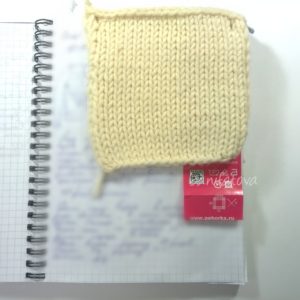 Very often, craftswomen prefer to experiment with knitted products rather than just knitting, strictly following the recommendations of magazine articles and special books.
Very often, craftswomen prefer to experiment with knitted products rather than just knitting, strictly following the recommendations of magazine articles and special books.
In this case, the consumption of materials must be calculated independently. The yarn chosen for the project may be rare or quite expensive. Therefore, it becomes important not to make a mistake with the quantity by buying too many or too few threads.
Number of yarn per hat
Each skein has a specific thread length and weight. Before purchasing material, you need to find a thread with a similar texture in your balls. We'll tell you how to calculate the required volume of threads for knitting.
Self-calculation of yarn

If possible, you need to make a sample measuring 20 x 20 cm. The conditions must be closer to those that will be in the process of knitting the real product. So, for the sample it is better to use the same knitting needles that will be used in the future. The pattern and method of knitting, as well as its density, must match.
Pattern with one type of knitting
After washing, you need to calculate the area of the sample and its weight. Next, the area of the pattern or future hat is calculated. The resulting area is multiplied by the weight of the sample and divided by the area of the sample.
By simple mathematical calculations you can calculate the required volume of yarn. This method is especially convenient to use if you have stale materials without labels.
Sample with different patterns

If different knitting options are combined in a hat, then you can conduct the following experiment.
It is necessary to knit a sample measuring 10 x 10 cm, alternating different techniques.
Next, you should wash it, dry it and see how the fabric deforms: it stretches or shrinks.
Then count the number of loops and rows in 10 cm. This data must be recorded and saved.
After this, we unravel the sample and calculate the footage. To do this, it is very convenient to mark a distance of 1 m on the table surface.
In the future, you can take measurements simply by applying threads without using a ruler. Next, calculate the area of the future hat and the number of squares that fit into it. Then we multiply the number of squares required by the area of one. We convert the resulting number into skeins using the length of the thread.
What determines the volume of yarn?

The yarn has its own unique number, indicated on the tag of each factory-made skein. It consists of two digits separated by a fraction. For example, it may be written 12/3 or 32/2. The first number indicates the volume of the thread. The larger it is, the thinner the thread. Another number tells you how many strands the thread is made of.
IMPORTANT! The looser the threads are twisted with each other and the larger the yarn, the less its consumption for knitting a hat.
It should be understood that after washing the material loses up to 10% of its weight. This is especially true for natural wool threads.Therefore, it is recommended to add up to 100 g of thread to the experimentally calculated data, taking into account their shrinkage. After purchase, the material should be washed.
Knitting density also plays a significant role. Thus, the yarn consumption for an openwork hat is noticeably reduced. By the way, skilled craftswomen who work to order know this. They can knit the product, leaving a couple of skeins for themselves.
How much yarn is needed for a hat?

Of course, each master can count the amount of yarn based on his individual knitting characteristics. But there are also general average statistical calculations.
The amount of yarn per hat is approximately 100 to 200 g.
- Women's model size 38 - from 150 g.
- Men's model size 50 - 150–200 g.
- Children's model size 30 - from 100 g.
These data are taken taking into account knitting a hat without making decorative elements. Many craftsmen also like to decorate their products with additional knitted decor. So, knitted flowers look impressive on hats. In this case, the volume of threads increases.
Tips for choosing yarn for a hat
In most cases, a hat is knitted using a variety of techniques. This affects the thread volume. Check out the advice of experienced knitters to help you determine more accurately how many skeins of yarn you will need.
- Most craftswomen advise buying more yarn for knitting than you need, that is, with a small margin. There is also a psychological moment here: knowing that there is enough material for the work, the needlewoman will knit much better and more calmly, without worrying that the product will be unfinished. You don’t even have to buy more skeins when choosing the right shade.
- The use of various elastic bands increases yarn consumption, and openwork techniques, on the contrary, reduce it.
- The Internet offers many special calculator services that help calculate the amount of yarn for a hat in a matter of seconds. Take advantage of it. The craftswoman only needs to indicate the size, type of product and the number of loops in 10 cm of the pattern. This method especially helps beginner needlewomen who have little practice and doubt their own abilities.
There are many proven ways to calculate the appropriate amount of yarn for knitting a hat. We hope that this article will be useful and help you connect a beautiful and fashionable product.


 0
0





